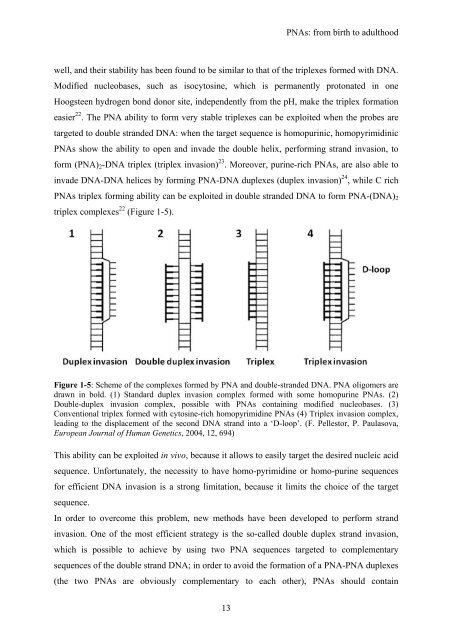View - DSpace UniPR
View - DSpace UniPR
View - DSpace UniPR
Create successful ePaper yourself
Turn your PDF publications into a flip-book with our unique Google optimized e-Paper software.
PNAs: from birth to adulthood<br />
well, and their stability has been found to be similar to that of the triplexes formed with DNA.<br />
Modified nucleobases, such as isocytosine, which is permanently protonated in one<br />
Hoogsteen hydrogen bond donor site, independently from the pH, make the triplex formation<br />
easier 22 . The PNA ability to form very stable triplexes can be exploited when the probes are<br />
targeted to double stranded DNA: when the target sequence is homopurinic, homopyrimidinic<br />
PNAs show the ability to open and invade the double helix, performing strand invasion, to<br />
form (PNA) 2 -DNA triplex (triplex invasion) 23 . Moreover, purine-rich PNAs, are also able to<br />
invade DNA-DNA helices by forming PNA-DNA duplexes (duplex invasion) 24 , while C rich<br />
PNAs triplex forming ability can be exploited in double stranded DNA to form PNA-(DNA) 2<br />
triplex complexes 22 (Figure 1-5).<br />
Figure 1-5: Scheme of the complexes formed by PNA and double-stranded DNA. PNA oligomers are<br />
drawn in bold. (1) Standard duplex invasion complex formed with some homopurine PNAs. (2)<br />
Double-duplex invasion complex, possible with PNAs containing modified nucleobases. (3)<br />
Conventional triplex formed with cytosine-rich homopyrimidine PNAs (4) Triplex invasion complex,<br />
leading to the displacement of the second DNA strand into a ‘D-loop’. (F. Pellestor, P. Paulasova,<br />
European Journal of Human Genetics, 2004, 12, 694)<br />
This ability can be exploited in vivo, because it allows to easily target the desired nucleic acid<br />
sequence. Unfortunately, the necessity to have homo-pyrimidine or homo-purine sequences<br />
for efficient DNA invasion is a strong limitation, because it limits the choice of the target<br />
sequence.<br />
In order to overcome this problem, new methods have been developed to perform strand<br />
invasion. One of the most efficient strategy is the so-called double duplex strand invasion,<br />
which is possible to achieve by using two PNA sequences targeted to complementary<br />
sequences of the double strand DNA; in order to avoid the formation of a PNA-PNA duplexes<br />
(the two PNAs are obviously complementary to each other), PNAs should contain<br />
13
















